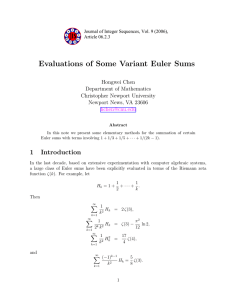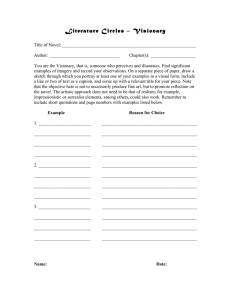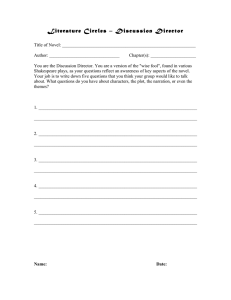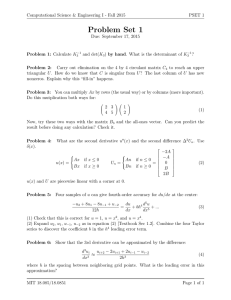Acta Mathematica Academiae Paedagogicae Ny´ıregyh´aziensis 24 (2008), 221–225 www.emis.de/journals ISSN 1786-0091
advertisement
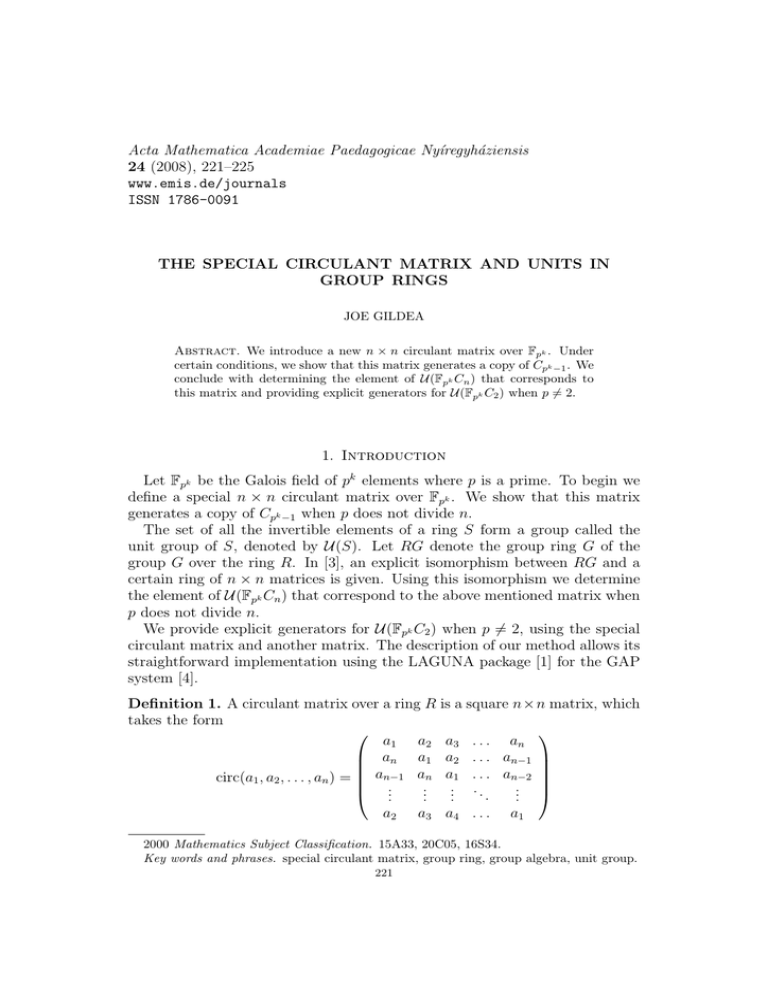
Acta Mathematica Academiae Paedagogicae Nyı́regyháziensis
24 (2008), 221–225
www.emis.de/journals
ISSN 1786-0091
THE SPECIAL CIRCULANT MATRIX AND UNITS IN
GROUP RINGS
JOE GILDEA
Abstract. We introduce a new n × n circulant matrix over Fpk . Under
certain conditions, we show that this matrix generates a copy of Cpk −1 . We
conclude with determining the element of U(Fpk Cn ) that corresponds to
this matrix and providing explicit generators for U(Fpk C2 ) when p 6= 2.
1. Introduction
Let Fpk be the Galois field of pk elements where p is a prime. To begin we
define a special n × n circulant matrix over Fpk . We show that this matrix
generates a copy of Cpk −1 when p does not divide n.
The set of all the invertible elements of a ring S form a group called the
unit group of S, denoted by U(S). Let RG denote the group ring G of the
group G over the ring R. In [3], an explicit isomorphism between RG and a
certain ring of n × n matrices is given. Using this isomorphism we determine
the element of U(Fpk Cn ) that correspond to the above mentioned matrix when
p does not divide n.
We provide explicit generators for U(Fpk C2 ) when p 6= 2, using the special
circulant matrix and another matrix. The description of our method allows its
straightforward implementation using the LAGUNA package [1] for the GAP
system [4].
Definition 1. A circulant matrix over a ring R is a square n×n matrix, which
takes the form
a1 a2 a3 . . . an
an a1 a2 . . . an−1
a
an a1 . . . an−2
circ(a1 , a2 , . . . , an ) =
n−1
..
.. . .
..
...
.
.
.
.
a2 a3 a4 . . . a1
2000 Mathematics Subject Classification. 15A33, 20C05, 16S34.
Key words and phrases. special circulant matrix, group ring, group algebra, unit group.
221
222
JOE GILDEA
where ai ∈ R.
For further details on circulant matrices see Davis [2].
Let R be a ring and Cn be the cyclic group of order n. There exists an
isomorphism between RCn and a certain ring of n × n matrices over R given
n−1
X
by σ :
ai xi 7→ circ(a0 , a1 , . . . , an−1 ). See [3] for further details.
i=0
2. The Special Circulant Matrix
Definition 2. Let a ∈ Fpk where a generates U(Fpk ) and p is a prime. Define
the special circulant matrix of order n over Fpk by
Gn = circ(1 + (n − 1)a, 1 − a, . . . , 1 − a).
|
{z
}
(n−1)−times
Example 3. G2 = circ(1 + a, 1 − a) and G3 = circ(1 + 2a, 1 − a, 1 − a).
Proposition 4. Let A = circ(γ, δ, . . . , δ ), where A is a n × n matrix and
| {z }
(n−1)−times
γ, δ ∈ Fpk and p is a prime. Then |A| = (γ + (n − 1)δ)(γ − δ)n−1 .
Proof. Let A = circ(γ, δ, . . . , δ), where A is a n × n matrix and γ, δ ∈ Fpk .
Then
¯
¯
¯1 1 . . . 1 ¯
¯
¯
¯δ γ . . . δ ¯
|A| = (γ + (n − 1)δ) ¯¯ .. .. . . .. ¯¯
. .¯
¯. .
¯δ δ . . . γ ¯
¯
¯
¯1
0
...
0 ¯
¯
¯
¯δ γ − δ . . .
0 ¯
¯
¯
0
...
0 ¯
= (γ + (n − 1)δ) ¯¯δ
..
.. ¯¯
...
¯ ...
.
. ¯
¯
¯δ
0
. . . γ − δ¯
= (γ + (n − 1)δ)(γ − δ)n−1 .
¤
Proposition 5. Suppose that p does not divide n. Then
(i) Gn is invertible.
(ii) Gn N = nN −1 circ(1 + (n − 1)aN , 1 − aN , . . . , 1 − aN ).
{z
}
|
(n−1)−times
THE SPECIAL CIRCULANT MATRIX AND UNITS IN GROUP RINGS
223
Proof. (i)
|Gn | = (1 + (n − 1)a + (n − 1)(1 − a))(1 + (n − 1)a − (1 − a))n−1
= (1 + na − a + n − na − 1 + a)(1 + na − a − 1 + a)n−1
= (n)(na)n−1
= nn an−1 .
Therefore Gn is invertible if p does not divide n.
(ii) We prove this by induction on N . Let N = 1, clearly Gn 1 = Gn . Now
let’s assume that it holds for N = k. i.e.
Gn k = nk−1 circ(1 + (n − 1)ak , 1 − ak , . . . , 1 − ak ).
|
{z
}
(n−1)−times
We must show that
Gn k+1 = nk circ(1 + (n − 1)ak+1 , 1 − ak+1 , . . . , 1 − ak+1 ).
|
{z
}
(n−1)−times
Gn k+1 = Gn k × Gn 1 =
1 + (n − 1)ak
1 − ak
1 − ak
...
1 − ak
1 − ak
1 + (n − 1)ak
1 − ak
...
1 − ak
k
k
k
k
k−1
1−a
1−a
1 + (n − 1)a . . .
1−a
=n
.
.
.
.
.
..
..
..
..
..
k
k
k
k
1−a
1−a
1−a
. . . 1 + (n − 1)a
1 + (n − 1)a
1−a
1−a
...
1−a
1−a
1 + (n − 1)a
1−a
...
1−a
.
1−a
1−a
1 + (n − 1)a . . .
1−a
×
.
.
.
.
.
..
..
..
..
..
1−a
1−a
1−a
. . . 1 + (n − 1)a
When we multiply these matrices every diagonal entry will be of the form
(†)
(1 + (n − 1)ak )(1 + (n − 1)a) + (n − 1)(1 − ak )(1 − a)
and every off diagonal entry has the form
(‡) (1 + (n − 1)ak )(1 − a) + (1 − ak )(1 + (n − 1)a) + (n − 2)(1 − ak )(1 − a).
(1 + (n − 1)ak )(1 + (n − 1)a) + (n − 1)(1 − ak )(1 − a)
= 1 + (n − 1)a + (n − 1)ak + (n − 1)2 ak+1 + (n − 1)(1 − a − ak + ak+1 )
= n + (n − 1)2 ak+1 + (n − 1)ak+1
= n + (n2 − 2n + 1 + n − 1)ak+1
= n + (n2 − n)ak+1
= n(1 + (n − 1)ak+1 ).
224
JOE GILDEA
(1 + (n − 1)ak )(1 − a) + (1 − ak )(1 + (n − 1)a) + (n − 2)(1 − ak )(1 − a)
= 1 − a + (n − 1)ak − (n − 1)ak+1 + 1 + (n − 1)a − ak − (n − 1)ak+1
+ (n − 2) − (n − 2)a − (n − 2)ak + (n − 2)ak+1
= n + (−2(n − 1) + (n − 2))ak+1
= n + (−2n + 2 + n − 2)ak+1
= n − nak+1
= n(1 − ak+1 ).
Therefore Gn k × Gn 1 = nk circ(1 + (n − 1)ak+1 , 1 − ak+1 , . . . , 1 − ak+1 ) = Gn k+1 .
|
{z
}
(n−1)−times
¤
Theorem 6. For a prime p which does not divide n, hGn i ∼
= Cpk −1 .
Proof.
k −1
Gn p
= np
k −2
circ(1 + (n − 1)ap
= np
k −2
circ(1 + (n − 1).1, 1 − 1, . . . , 1 − 1)
pk −1
=n
= In
k −1
k −1
, 1 − ap
|
k
, . . . , 1 − ap −1 )
{z
}
(n−1)−times
In
since a generates U(Fpk ) and n ∈ U(Fpk ).
Consider nN −1 (1 − aN ), which is an off diagonal entry of Gn N . Now nN −1 (1 −
aN ) = 0 ⇐⇒ 1 − aN = 0 ⇐⇒ aN = 1 ⇐⇒ N = pk − 1 since a generates U(Fpk )
and n ∈ U(Fpk ). Therefore hGn i ∼
¤
= Cpk −1 .
Let An = diagn (a) where a generates U(Fpk ) and p is a prime. Clearly
hAn i ∼
= Cpk −1 . Also hAn i ∩ hGn i = In since 1 − aN = 0 iff N = pk − 1.
à n−1 !
X
Corollary 7. Let αn = (1 + (n − 1)a) + (1 − a)
xi ∈ Fpk Cn where a
i=1
generates U(Fpk ), p is a prime and Cn = hx | xn = 1i. Suppose p - n, then
(i) hαn i ∼
= Cpk −1 .
(ii) α2 and a generate U(Fpk C2 ).
Proof. (i) σ(α) = Gn .
(ii) σ(a) = A2 , σ(α2 ) = G2 and h A2 , G2 i ∼
= Cpk −1 × Cpk −1 .
¤
References
[1] V. Bovdi, A. Konovalov, R. Rossmanith, and C. Schneider. Laguna – lie algebras and
units of group algebras. http://www.cs.st-andrews.ac.uk/ alexk/laguna.htm, 2007. Version 3.4.
[2] P. J. Davis. Circulant matrices. John Wiley & Sons, New York-Chichester-Brisbane,
1979. A Wiley-Interscience Publication, Pure and Applied Mathematics.
THE SPECIAL CIRCULANT MATRIX AND UNITS IN GROUP RINGS
225
[3] T. Hurley. Group rings and rings of matrices. Int. J. Pure Appl. Math., 31(3):319–335,
2006.
[4] The GAP Group. Gap – groups, algorithms, and programming. http://www.gapsystem.org, 2007. Version 4.4.10.
Received February 28, 2008.
Department of Mathematics,
National University of Ireland,
Galway,
IRELAND
E-mail address: gildeajoe@gmail.com


